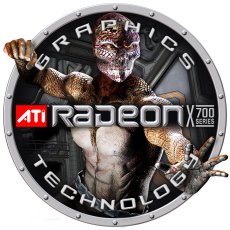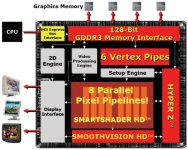Introduction

In this review we're taking a look at two versions of the Radeon X700, both ATI's higher end, reference X700 XT and one of ATI's partner vendor's PRO variants, the Sapphire Hybrid Radeon X700 PRO.
Overview
Radeon X700 has been designed to fill the mainstream market segment, for those that want decent gaming performance but at good value. Fundamentally the main idea appears to have been to bring last years high end performance, such as that of the Radeon 9800 PRO, into this years mainstream parts as there is a gulf in performance between the current 12 / 16 pipe X800's and the previous mainstream parts of 9600 / X600. However, in designing the RV410 chip that is the core of the Radeon X700's ATI have hit upon a curious mix of performance features: the chip retains a 2 quad pixel pipeline organisation, similar to that of 9800, however 9800's 256-bit memory bus is not retained, leaving a 128-bit bus, but all 6 vertex shader units from X800's configuration have been retained as opposed to the 4 units in 9800 and 2 in all the other previous mainstream parts!
ATI has a history of continuing with the previous generation by trickling it into the low end when they introduce a new high end part, however the lines have become increasingly blurred as more chips of similar generations are being produced at the same time - the Radeon 9000 series consisted of a mix of DirectX8.1 and 9 generation parts, with the DirectX9 architecture being moved down to the mainstream position after the first refresh. The "X" series is again based on a mix of platforms, with the lower end X300 and X600 being functionally equivalent chips as Radeon 9600, but on the PCI Express bus, and the higher end X800 is based on a tweaked architecture to offer more features, capabilities and address some of the weaker elements of the R300 architecture. Rather than being based on R300, RV410's architecture is taken from R420 which results in X700 having longer pixel shader instruction capabilities and 3Dc normal map compression. The memory bus is also based on the new programmable memory bus from R420, which allows for much higher memory clock rates than any R300 based part, thus enabling X700 to utilise higher performance memory, making up a little for the lack of 256-bit memory bus.
Later in this review we'll look at where this mix of features and performance characterises lands the X700 XT and PRO in terms of performance in relation to the contemporary line and last years Radeon 9800 PRO.


